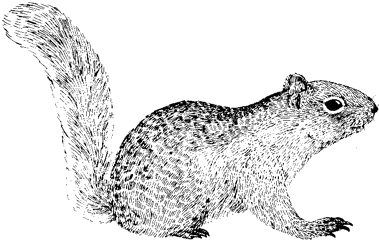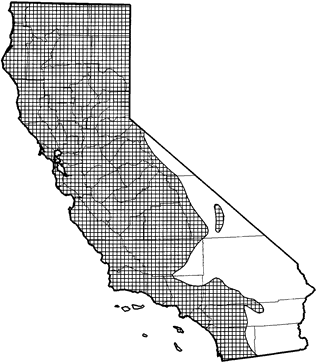
California Ground Squirrel
Distribution, Abundance, and Seasonality
Very common permanent resident the length of the state, excluding parts of the Basin Ranges, and the Mojave and Colorado Desert regions. Widespread throughout almost all habitats in earlier successional stages. These ground squirrels commonly use openings and disturbed areas, particularly along roadsides, in croplands, and in grazed meadows. Occur from sea level to about 3333 m (0 to 11,000 ft) elevation.

Range Map
Specific Habitat Requirements
Feeding: California ground squirrels are omnivorous. They eat seeds, nuts, fruits, bulbs, fungi, and stems and leaves of grasses and forbs. They also eat some insects, bird eggs, and carrion. Forage on the ground, and in low shrubs and trees. Also dig up plants. Store food for inactive periods.
Cover: Cover is provided by burrows excavated in friable soils, often near rocky areas or under trees or logs. Burrow system may be elaborate, with 6-20 entrances. Tunnel lengths average 11 m (35 ft), and range from 0.9-42 m (3-138 ft).
Reproduction: Build cup-shaped nests of dried vegetation in the burrow.
Water: Apparently very little water required.
Pattern: Suitable areas for California ground squirrels are herbaceous sites, and openings in most brush and forest habitats. Friable soils are required, and rocks, scattered trees, logs, and other ground cover enhance the habitat.
Species Life History
Activity Patterns: Diurnal activity. May become torpid for periods of time when food is scarce and temperatures are extreme; especially fall and winter at high elevations, and in late summer in hot, lowland areas. Timing of inactivity varies greatly with individuals, populations, weather, and habitat.
Seasonal Movements / Migration: Non-migratory.
Home Range: Home ranges usually are less than 137 m (450 ft) radius around burrows. In California, home ranges of males averaged 0.1 ha (0.4 ac); those of females averaged 0.2 ha (0.6 ac) (Evans and Holdenreid 1943). Individual home ranges often overlap considerably.
Territory: May live singly, or in small, dispersed colonies of 1, or more, families (Maser et al. 1981). May hold small territories during breeding season (Evans and Holdenreid 1943). Little data on territories found, and Fitch (1948) suggested that they do not hold territories.
Reproduction: Females are polyestrous. Timing of breeding season varies greatly throughout California. Mating occurs from January through July, with peak activity in March through June. Following a gestation period of about 30 days, an average of 6-7 young are born (range 3-15). Litter size is correlated inversely with latitude (Chapman and Lind 1973). Females produce 1 litter per yr. Young are weaned at about 55 days, and are full-grown in 7-8 mo.
Niche: California ground squirrels are important prey for many carnivores. Population numbers usually increase in heavily grazed areas, as forb production and visibility increase. Can damage crops. Can harbor plague, which may decimate numbers.
Sources & References
California Department of Fish and Game, 1999.
California's Wildlife, Sacramento, CA.
Written by: C. Polite, G. Ahlborn, reviewed by: M. White, edited by: M. White
Chapman, J. A., and G. S. Lind. 1973. Latitude and litter size of the California ground squirrel, Spermophilus beecheyi. Bull. Southwestern Calif. Acad. Sci. 72:101-105. Evans, F. c., and R. Holdenried. 1943. A population study of the Beechey ground squirrel in central California. J. Mammal. 24:231-260. Fitch, H. S. 1948. The ecology of the California ground squirrel on grazing lands. Amer. Midl. Nat. 39:513-596. Grinnell, J., and J. Dixon. 1919. Natural history of the ground squirrels of California. Calif. State Comm. Horticulture Bull. 7:597-708. Ingles, L. G. 1965. Mammals of the Pacific states. Stanford Univ. Press, Stanford, CA. 506pp. Linsdale, J. M. 1946. The California ground squirrel. Univ. Calif. Press, Berkeley. 476pp. Maser, C., B. R. Mate, J. F. Franklin, and C. T. Dyrness. 1981. Natural history of Oregon coast mammals. Pac. Northwest For. And Range Exp. Sta., USDA, For. Serv., Gen. Tech. Rep., PNW-133. 496pp. Schitoskey, F., Jr., and S. R. Woodmansee. 1978. Energy requirements and diet of the California ground squirrel. J. Wildl. manage. 42:373-382. Sumner, L., and J. S. Dixon. 1953. Birds and mammals of the Sierra Nevada. Univ. California Press, Berkeley. 484pp.
California Animal Facts | California's Wildlife